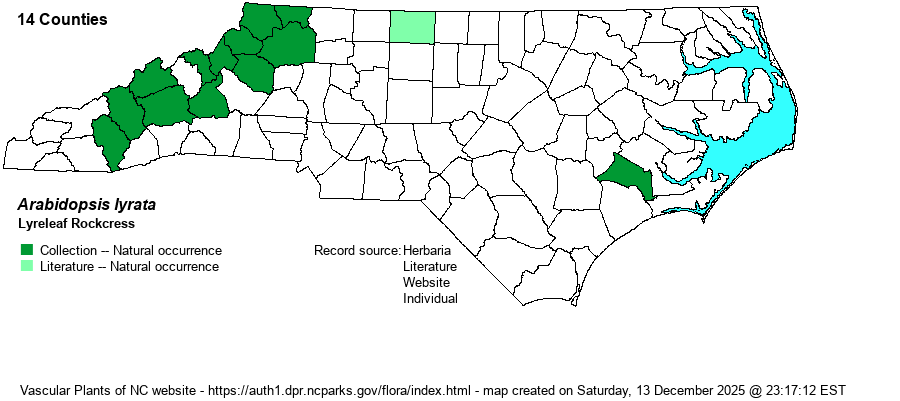| Author | O'Kane & Al-Shehbaz | |
| Distribution | Present over most of the northern and central Mountains, south to Jackson County. Also known from a few isolated sites in the western Piedmont (Rockingham County) and disjunct to the Coastal Plain (Jones County).
This is a Northern species, present across southern Canada and south to NJ, PA, and MN, but only sporadically south mainly in mountains. It ranges only to NC and TN in the East. | |
| Abundance | Uncommon and somewhat local in the Mountains, restricted in habitat to certain rock outcrops. Extremely rare into the Piedmont and eastern Coastal Plain. This is a Watch List species. | |
| Habitat | This species has a limited habitat, essentially on mafic or calcareous rock outcrops. This can be amphibolite, limestone, or marl (Jones County); it may grow occasionally at some granitic outcrops, but as a general rule this species requires thin high pH soil. It often grows on cracks in cliffs and at rocky summits, as well as around the margins of domes or other outcrops. | |
| Phenology | Blooms mainly from March to June, and occasionally later; fruits from April to September. | |
| Identification | This is a rather small species, often branched at the base, with a basal rosette. These small leaves are quite unusual, in that they are pinnately lobed, despite being only about 1-inch long. Thus, you might be able to identify it just by the basal leaves. The rest of the plant is rather typical -- stems ranging to about 8 inches tall, with only a few scattered, alternate leaves on it, linear and about 2 inches long, though somewhat variable in length and shape. Topping each branch is a small flower cluster, and each of the few flowers has 4 white petals, producing a flower about 2/3-inch across, not small given the small and slender size of the plant. The fruit are siliques, each straight and about 1-1.5 inches long, often ascending. You are more likely to identify the species by its tiny "dandelion"-like cluster of basal leaves, each cut like a leaf of that weed, than with the vertical part of the plant -- especially as the basal rosette is found on rocks and their crevices. | |
| Taxonomic Comments | This species was long known as Arabis lyrata, but most recent references have moved it to Arabidopsis. Weakley (2018) gives subspecies for it, and the nominate one is found in NC.
| |
| Other Common Name(s) | Dwarf Rockcress, Sand Cress, Lyrate Rockcress | |
| State Rank | S2 | |
| Global Rank | G5 | |
| State Status | [W1] | |
| US Status | | |
| USACE-agcp | FACU link |
| USACE-emp | FACU link |

